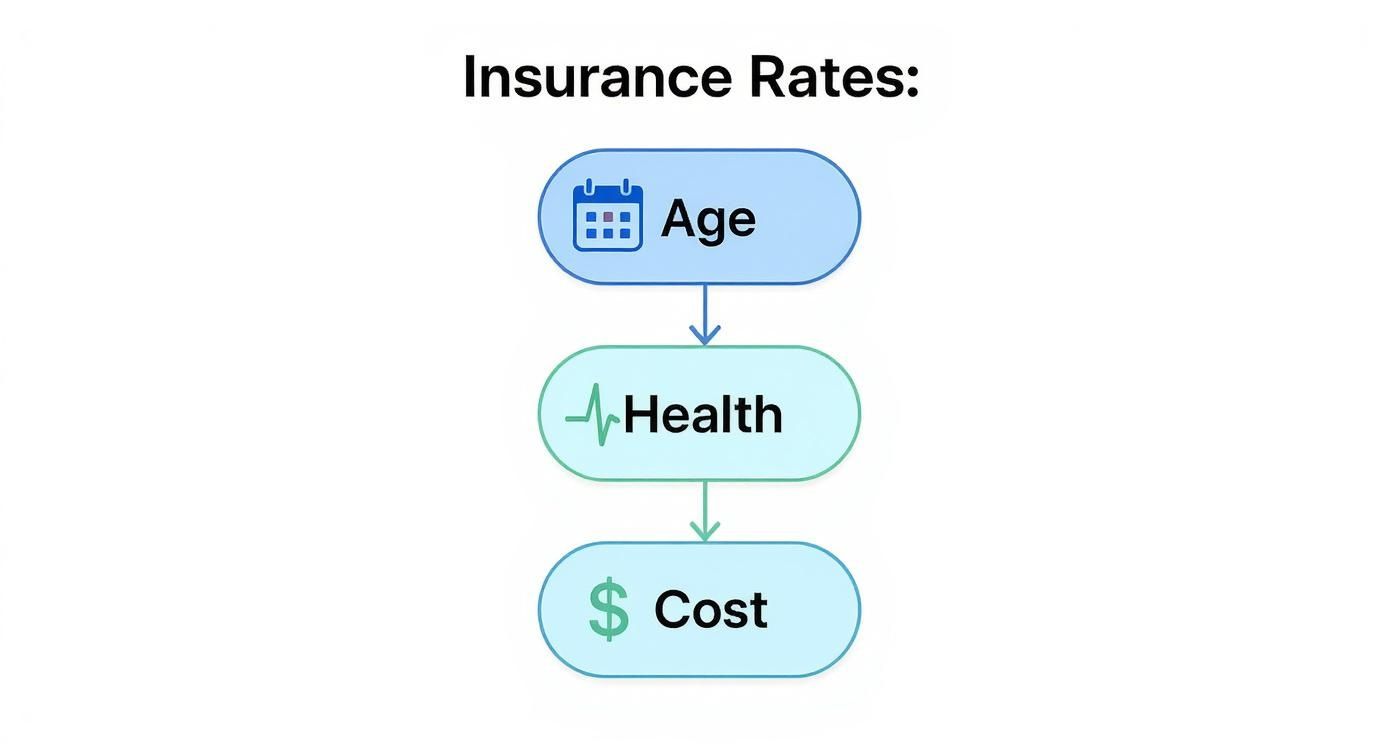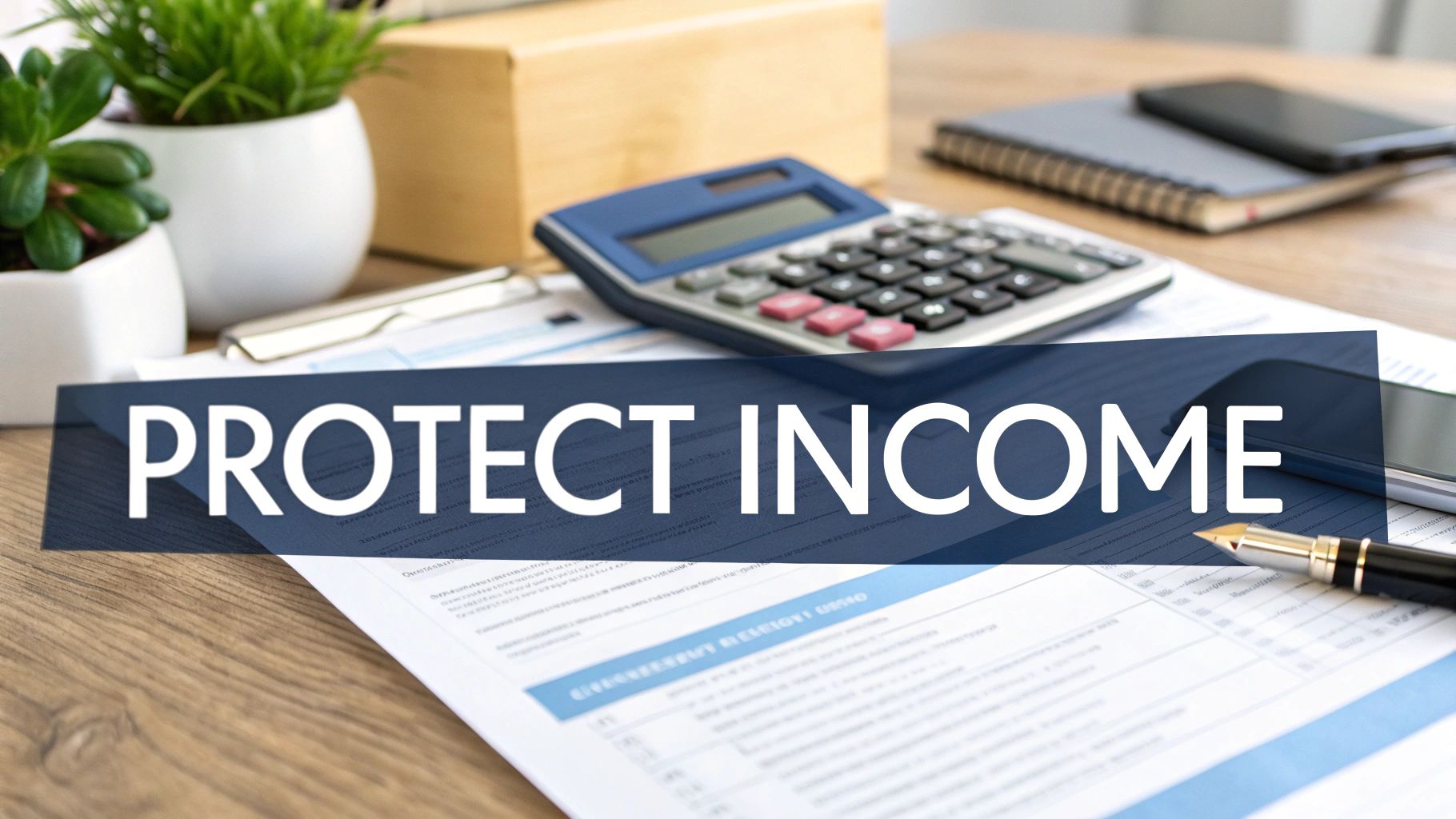So, when’s the right time to get life insurance?
The short answer is simple: as soon as someone else depends on your income.
For most of us, that means buying it when we’re young and healthy. Think of it like booking a flight—the earlier you buy your ticket, the less you'll pay. Locking in a policy sooner rather than later almost always saves you money.
Why Timing Your Life Insurance Purchase Matters

Deciding when to buy life insurance is one of the biggest financial moves you can make. This isn’t just about planning for a worst-case scenario; it’s about smart financial strategy.
Two things have the biggest impact on your premiums: your age and your health. The younger and healthier you are, the lower your rates will be. Period. The best part? You can lock in that low rate for decades to come.
Insurance companies base their prices on risk. A healthy 28-year-old is, statistically, a much lower risk than a 48-year-old who might be developing a few health issues. Waiting just a few years can mean paying way more over the life of your policy.
Key Triggers Driving the Decision
Knowing when to buy really just means recognizing the big moments in your life that create a need for it. These aren't abstract ideas—they're practical responses to new responsibilities.
Most of these triggers fall into a few clear categories:
- Financial Dependents: Do you have a spouse, kids, or even aging parents who count on your paycheck to get by?
- Major Debt: Did you just buy a house, take out a business loan, or cosign on student loans?
- Future Financial Goals: Are you saving for your child's college fund or want to make sure your partner can retire comfortably one day?
These are the moments when a financial safety net goes from a "nice-to-have" to a "must-have." As you think about this, it’s a good idea to explore all your options. For instance, a detailed guide to survivorship life insurance can show you different types of policies that might fit your unique situation.
The real purpose of life insurance is to replace your economic value for the people who depend on you. The second that dependency starts, your need for insurance begins.
Lots of young people ask if the cost is worth it early on. We break that down in our guide on whether life insurance is worth it if you're young.
Ultimately, buying life insurance is one of the most proactive things you can do to protect your family's future. And acting early delivers the most peace of mind for the lowest cost.
Key Triggers for Buying Life Insurance
To make it even clearer, here are the most common life events that should put life insurance on your radar.
| Life Event Trigger | Primary Reason to Get Coverage | Potential Consequence of Delaying |
|---|---|---|
| Getting Married | To protect your spouse from debt and loss of income. | Your partner could struggle financially if left with shared bills. |
| Having a Child | To ensure your child's future is secure (college, living expenses). | Your child's long-term financial stability could be at risk. |
| Buying a Home | To cover the mortgage so your family doesn't lose their home. | Your family may be forced to sell the house to pay off the loan. |
| Starting a Business | To protect business partners and cover business loans. | The business could fail without you, leaving partners with debt. |
| Taking on Student Loans | To prevent cosigners (like parents) from being stuck with your debt. | Your loved ones could be legally obligated to repay your loans. |
Recognizing these triggers helps you see life insurance not as an expense, but as a crucial tool for protecting what—and who—matters most.
How Your Age and Health Affect Your Life Insurance Rates
When it comes to life insurance, two things matter more than anything else: your age and your health.
Think of it like this. Getting life insurance in your 20s is like buying a warranty for a brand-new car right off the lot. The risk of a major breakdown is super low, so the coverage is cheap and easy to get.
But trying to get that same warranty for a 15-year-old car with 200,000 miles? That’s a whole different ball game. The risk is sky-high, so the price will be too—if you can even find a company willing to offer it. Life insurance works on the exact same principle.
Insurance companies see younger, healthier people as a lower risk, and that translates directly into lower monthly payments for you. By getting a policy when you're young and healthy, you can lock in a surprisingly affordable rate for the next 20 or 30 years.
The Real Cost of Waiting
Every birthday that passes can nudge your potential life insurance premium a little higher. A single year might not feel like a big deal, but it adds up faster than you’d think. On average, premiums can jump by 8% to 10% for every year you put it off.
Why the hike? It’s simple statistics. As we get older, the odds of developing a health issue go up. Insurers are in the business of measuring that risk.
The longer you wait, the more time there is for things to pop up—from high blood pressure to more serious conditions—that can either drive up your rates or make it tougher to get covered at all.
This is exactly why so many people finally buy a policy when life gets real—they get married, have a kid, or sign a mortgage. The global life insurance market, valued at a massive $3.1 trillion, is proof that people recognize this need as their responsibilities grow.
A Quick Look at the Underwriting Process
The official name for this risk-check is underwriting. This is where the insurance company dives into your application, health records, and lifestyle to figure out what your premium should be. It’s the bridge connecting your personal health to the price you pay.
So, what are they looking at?
- Your current age and health: This is the big one. It's the starting point for everything.
- Your family’s medical history: If certain conditions run in your family, it can play a role.
- Your lifestyle choices: Things like smoking or having high-risk hobbies will definitely increase your premium.
- Your driving record: A clean record can sometimes help you score a better rate.
Every piece of information helps the insurer paint a clear picture of their risk. If you want to see the full breakdown of this crucial step, you can learn more about the life insurance underwriting process in our detailed guide.
Ultimately, the best strategy is the simplest one: get coverage when you’re young and your health is at its peak. It's the smartest move you can make for long-term affordability.
Life Milestones That Signal It’s Time for Coverage
Knowing that age and health affect your rates is one thing, but that’s all theory. The real "when" for buying life insurance usually arrives with big life events. These are the moments when your responsibilities suddenly get bigger, and someone else’s future becomes tied to yours.
Think of your financial life like a simple one-lane road when you're young and single. It's pretty straightforward. But every time you hit a major milestone—getting married, buying a home, having a kid—you’re adding another lane. The road gets wider and way more complex. That's when you need to install some guardrails to keep everyone safe. Life insurance is one of the most important guardrails you can have.
Getting Married or Committing to a Partner
When you decide to combine your life with someone else's, that’s one of the clearest signs it's time to think about life insurance. Suddenly, your income isn't just for you anymore. It supports a shared future, shared bills, and shared dreams.
If something happened to you, your partner would be left holding the bag for everything—alone. That means covering daily expenses, the rent or mortgage, and any debt you took on together. A life insurance policy provides an immediate financial cushion, making sure your partner doesn’t have to make impossible choices during an already heartbreaking time.

The takeaway here is simple: the younger and healthier you are when you lock in a policy, the less you'll pay in premiums over its entire lifetime.
Buying Your First Home
Signing the papers on your first home is an incredible feeling. But let's be real—it’s also probably the biggest debt you'll ever have. A mortgage is a long-term promise, and for most couples, it's a promise that relies on two incomes to stay afloat.
Without life insurance, that shared investment can quickly turn into a crushing burden for the surviving partner. The policy’s death benefit can wipe out the remaining mortgage balance, ensuring your family gets to keep their home.
It's about protecting the asset you worked so hard to build. It gives your loved ones a stable roof over their heads without the threat of foreclosure hanging over them.
Welcoming a Child into Your Family
The moment you become a parent, your entire financial world shifts. You are now 100% responsible for a tiny human who depends on you for absolutely everything, from diapers and daycare today to college tuition down the road. This is, without a doubt, the most powerful reason to get life insurance.
Protecting your kids' future is what it's all about. A policy can make sure there’s money set aside for:
- Daily living expenses until they’re grown up.
- Childcare and education costs, all the way through college.
- Maintaining their quality of life even if your income is gone.
So many new parents feel overwhelmed and wonder where to even start. Our in-depth guide to life insurance for parents breaks down the options clearly. The right coverage is about more than money; it's the peace of mind that comes from knowing your kids will be taken care of, no matter what happens.
Financial Triggers You Should Never Ignore

While big life moments pull at the heartstrings, your financial journey sends its own clear signals about when to get life insurance. These triggers aren't about emotion; they’re about the cold, hard numbers. They’re the moments when your financial world shifts, creating new risks that demand a safety net.
Ignoring these shifts is like building a bigger, more beautiful house but never upgrading the flimsy lock on the front door. You’re simply creating more for your loved ones to potentially lose.
Taking On Significant Debt
One of the loudest alarms for needing life insurance is taking on a large amount of debt. A mortgage is the classic example, but any major loan can put your family in a tough spot if you’re no longer there to pay it.
This is especially true for any debt with a co-signer. For example, if your parents co-signed your private student loans, they could be on the hook for the entire balance if you were to pass away. A life insurance policy erases that risk, ensuring your debt doesn't become their financial nightmare.
Starting or Growing a Business
For entrepreneurs, life insurance isn't just a personal choice—it's a critical business move. When you launch a company, you’re often taking on big loans and have partners and employees who rely on you completely.
A special type of policy called key person insurance can literally save your business from collapsing if a founder or essential employee dies. The payout gives the company the cash it needs to hire a replacement, pay off debts, and stay afloat during a crisis.
This protects the business you've poured your heart into and safeguards your family’s financial stake in its future. As you build this safety net, understanding related legal documents is also key. Using resources like Estate Planning Forms can help clarify the bigger picture of protecting your assets.
Earning a Major Salary Increase
Getting that big promotion or a massive pay raise is definitely a reason to celebrate. It’s also the perfect time to give your life insurance a second look. A higher income almost always leads to a higher standard of living—a nicer home, better cars, and bigger dreams for your family.
Your old policy probably isn't enough to sustain that new lifestyle. Upping your coverage ensures your family is protected at their current standard of living, not the one you left behind years ago. If you're not sure how much you need now, our guide can help you calculate your life insurance need with confidence.
To see just how much is at stake, let's look at a few common financial triggers and compare the potential outcomes with and without a policy in place.
Financial Risk Assessment With and Without Life Insurance
| Financial Trigger | Risk Without Life Insurance | Protection With Life Insurance |
|---|---|---|
| Buying a Home | The surviving partner or family may be forced to sell the home to cover the mortgage. | The policy payout can pay off the mortgage, allowing the family to stay in their home. |
| Co-signing a Loan | The co-signer (e.g., a parent) becomes fully responsible for the entire remaining debt. | The death benefit can be used to pay off the loan, removing the burden from the co-signer. |
| Starting a Business | The business may have to shut down, leading to job losses and financial ruin for partners. | Key person insurance provides funds to keep the business operational and find a replacement. |
| Receiving a Raise | The family’s lifestyle would have to be drastically reduced to match the lost income. | The increased coverage can replace the higher income, maintaining the family’s quality of life. |
As you can see, life insurance acts as a powerful financial backstop. It turns a potential crisis into a manageable situation, giving your loved ones stability when they need it most.
How Economic Conditions Influence Your Decision
While getting married or buying a home are obvious triggers for getting life insurance, there's a savvier way to time your purchase: by looking at the bigger economic picture.
Broader trends, especially interest rates, have a surprisingly big impact on both the cost and the growth of a life insurance policy. Understanding this lets you move from just reacting to life events to proactively planning your purchase for the best possible financial outcome.
Don't worry, you don't need a degree in economics to get this. The core idea is simple.
Think of a cash-value policy, like whole life, as something similar to a high-yield savings account. When interest rates across the economy go up, the "yield" on these policies—the rate your cash value grows—tends to climb, too. This gives the investment side of your policy a serious boost, helping you build wealth faster.
The Impact of Interest Rates
When interest rates are higher, insurance companies earn more on their own investments. A portion of that success gets passed along to policyholders, translating into better returns and faster cash value growth for you.
This is a big reason the global life insurance market has seen so much growth lately—rising interest rates are making policies with an investment component far more attractive. You can get more details on this trend and discover more insights about the global insurance market.
This economic timing is most important for permanent life insurance policies that have a built-in savings or investment component, such as:
- Whole Life Insurance: Known for its guaranteed cash value growth rate.
- Universal Life Insurance: Offers more flexibility, with growth often tied to market interest rates.
Even for term life insurance—which is pure protection with no savings feature—interest rates still play a role, though it’s less direct.
Seizing the Right Economic Moment
So, when is the best time to buy life insurance based on the economy? A truly strategic move is to purchase a cash-value policy when interest rates are on the rise. You get to lock in a plan with the potential for stronger, more accelerated growth right from the start.
Timing your purchase during a favorable economic climate adds another layer of financial wisdom to your decision. It’s about ensuring your policy not only protects your loved ones but also works as efficiently as possible as a financial asset.
Now, this doesn't mean you should wait around for the perfect economic conditions while leaving your family unprotected. Your personal need for coverage—driven by your kids, your mortgage, or your business—always, always comes first.
But if you have the flexibility, being aware of these economic winds can help you make a much more informed decision, especially when you’re weighing your permanent life insurance options.
Life's Wake-Up Calls: Unexpected Health Scares
Life has a way of throwing curveballs. Sometimes, the biggest push to get life insurance doesn’t come from a happy milestone like getting married or buying a house. It comes from something much more jarring: a health scare.
These moments—whether it's a diagnosis out of the blue, a near-miss on the highway, or a global health crisis—are powerful. They’re a sudden, sharp reminder that we’re not invincible. That’s when the abstract idea of “what if” gets incredibly real, creating an urgent need to protect the people we love.
It’s human nature to think it won't happen to us… until it almost does.
The recent pandemic was a massive, collective wake-up call. As the reality of risk hit home for millions, life insurance sales saw a spike unlike anything in the last 40 years. It was a real-time lesson on why people suddenly prioritize coverage when faced with their own vulnerability. You can read the full research about these insurance market trends to see just how significant the shift was.
But What if You've Just Received a Diagnosis?
It’s a tough spot to be in. If you waited and are now facing a new health issue, it's easy to think you've missed your window. But that’s not always the case.
A new condition might make getting a traditional policy harder or more expensive, but it doesn’t shut the door completely. It just means your options look a little different.
Even when life doesn't go according to plan, there are still ways to build a financial safety net for your family. The most important thing is to explore every avenue without giving up.
There are specific policies designed for exactly this kind of situation. For example, guaranteed issue life insurance skips the medical exam and guarantees you’ll be accepted, though it usually offers a smaller benefit.
For a young, healthy person, it wouldn’t be the first choice. But for someone with a pre-existing condition, it can be an absolute lifeline. The bottom line? Acting quickly after a diagnosis—even if the options are more limited—is so much better than leaving your family with nothing. It’s about making the best move you can, right here, right now.
A Few Common Questions About Life Insurance
Diving into the world of life insurance can bring up a lot of questions. That’s completely normal. Getting clear, simple answers is the best way to move forward with confidence. Let's tackle some of the most common things people ask when timing their purchase.
Is It Ever Too Late to Buy Life Insurance?
The short answer? No, it's never technically "too late." But waiting definitely makes things more expensive and a bit trickier. As you get older or develop health issues, your choices can narrow, and premiums will climb.
That said, even if a traditional term policy seems out of reach, there are other paths. Policies like guaranteed issue or final expense insurance were specifically created for older folks or those with health challenges. The golden rule is always to buy as early as you can, but there are options available at almost any age.
The core idea is simple: the younger and healthier you are, the better your rates will be. But having some coverage is always better than having none, no matter when you start looking.
Should I Buy Term or Whole Life Insurance?
This is a big one, and it really comes down to what you want the policy to do for you.
Term life insurance is the most straightforward option. It gives you protection for a set period—like 20 or 30 years—and then it ends. It's affordable and perfect for covering temporary, but major, financial responsibilities. Think of things like paying off a mortgage or making sure your kids are covered until they're financially independent.
On the other hand, whole life insurance is permanent coverage that lasts your entire life. It costs more, but it also builds a cash value that grows over time. For most people, the classic "buy term and invest the difference" strategy makes the most sense. Whole life can be a powerful tool, but it's typically best for very specific, complex estate planning goals.
How Much Life Insurance Do I Really Need?
You'll often hear a rule of thumb that says you need coverage equal to 10-12 times your annual income. It’s a decent starting point, but a personalized number is always going to serve you better.
To get a more accurate figure, you need to add up a few key things:
- All your outstanding debts. This includes your mortgage, car loans, student loans—everything.
- The income your family would need to continue their current lifestyle without you.
- Big future expenses you were planning for, like your kids' college tuition or long-term care for a dependent.
There are plenty of great online calculators that can walk you through this and help you find a number that truly fits your family's unique situation.
Finding the right policy at the right time isn't just about a contract; it's about securing your family's future. At My Policy Quote, we make it easy to compare your options and find the perfect coverage for your needs. Explore your personalized life insurance quotes today!


